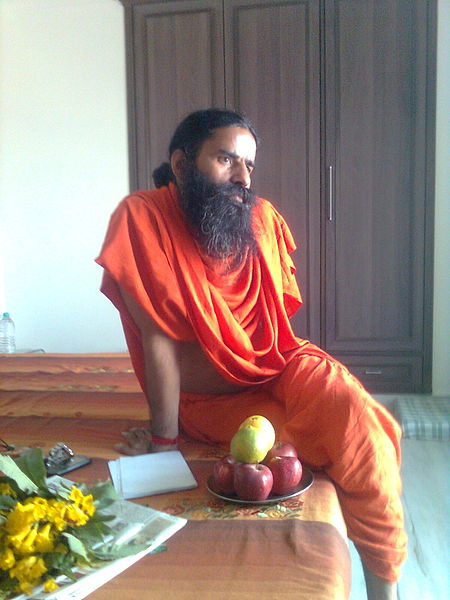
TV2 bringer denne uka nyheter om en amerikansk kvinne som påstår at hun lever på kun luft og sollys. Flere av hennes «tilhengere» – som kaller seg selv «breatharians» – har dødd i et forsøk på å gjøre det samme. Påstander som dette er intet nytt under solen, skriver Tulpesh Patel in Argument #3 2013: I India lurer fakirer og guruer millioner av mennesker til å tro at de ikke trenger mat og at yoga kan gjøre deg frisk fra kreft.
Who gives a flying fakir about evidence?
By Tulpesh Patel
Sanal Edamaruku, president of Rationalist International and the Indian Rationalist Association, was invited by Skepsis, Norway’s national scepticism organisation, to give a series of lectures around Norway in March of this year. At the Oslo Skeptics in the Pub meeting, Edamaruku talked about his fight against flying fakirs and starving saints – the various «holy men», and occasionally women, who take advantage of the poor and religious to amass huge personal fortunes. [pullquote align=»right»]Back in 2003, a sadhu by the name of Prahlad Jani caught the world’s attention when he claimed to have had his last meal sometime during the Second World War[/pullquote] These holy men perpetuate a brand of mysticism that is, when looked at in the best possible way, just regular magic. At its worst, however, the ideas they spread can be life-threatening, and they go some way to throttling India’s development and the well-being of its people.

Logic defiying
The vast majority of Indian holy men (sadhus) live a life of poverty, meditation, performing blessing ceremonies and getting high on marijuana. To achieve heightened spirituality, sadhus may meditate for days on end. The more hardcore sadhus take this asceticism further, claiming to perform feats which often defy logic and break the laws of physics. Over the years, these holy men have claimed they that have starved themselves for years, buried themselves, or even just their heads, underground for days on end, and even levitated – the so-called flying fakirs.
Fasting since WWII
Flying fakirs are easy to debunk, because the trick is so simple. It often consists of a man sitting on an elevated platform with the support frame hidden under shrouds of material, and an exclusion zone around him to stop people getting close enough to see what’s really going on.
Fasting for long periods is common amongst Indian holy men, but back in 2003, a sadhu by the name of Prahlad Jani caught the world’s attention when he claimed to have had his last meal sometime during the Second World War, with not a morsel of food or a sip of water passing his lips in the 60 years since. In 2003 physicians at Sterling Hospital in the western Indian city of Ahmedabad decided to keep Jani under observation for ten days. [pullquote]Indian holy men don’t have magical abilities, just a lot of charisma and a disregard for the truth, evidence and the well-being of others. [/pullquote] Afterwards they claimed that aside from 100mls of mouthwash, which he was required to spit back out and have measured, Jani ate and drank nothing and «passed neither urine nor stool.» Unfortunately, the investigation was never independently verified, nor was the data released to the public or published in scientific journals. Extraordinary claims require extraordinary evidence, and this wasn’t it. Starving saints are not just confined to India. The same kind of ascetism existed in Christianity; Anorexia mirabilis, (’miraculous lack of appetite’) is the term given to women and young girls during the Middle Ages who starved themselves in the name of God.
Uncontrolled observation
In April 2010 the experiment was repeated, with the same astounding results and with even more media coverage across the world. This time, however, Sanal Edamaruku was able to get a closer look at what was going on, although his investigation was constantly hampered by those running the investigation and the organisation funding it, the Indian Defence Institute of Physiology and Allied Sciences (Dipas). Edamaruku revealed that Jani was frequently allowed to leave the observation room to get his «sun baths», and that even when in his room, his activities weren’t closely monitored. Jani was occasionally seen going out of shot in the one camera that was supposed to be constantly monitoring him. He also received guests who blocked the view of the camera, and his regular gargling and bathing activities were not monitored properly, meaning he could drink some of the water that he poured over himself in the bath.
Sunlight Energy
Despite all these suspicious activities, Dr Sudhir Shah, Director of Neuroscience at Sheth V. S. General Hospital, Ahmedabad, and lead investigator on the «study», had this to say: «If Jani does not derive energy from food and water, he must be doing that from energy sources around him, sunlight being one. As medical practitioners, we cannot shut our eyes to possibilities, to a source of energy other than calories.» [pullquote align=»right»]At its worst, however, the ideas they spread can be life-threatening, and they go some way to throttling India’s development and the well-being of its people. [/pullquote] As a medical practitioner, that is the first thing he should be doing, but it turns out that Dr Shah has a pet theory about «sunshine as food» that he has convinced the Indian government to spend hundreds of thousands of rupees on, because of its potential military applications. Since the debunking, Jani has disappeared, but the Indian government continues to throw precious financial resources investigating Dr Shah’s ridiculous claims.
Rags and Riches
Swami Ramdev is currently one of the most popular holy men in India. Ramdev’s yoga shows are watched by around 30 million people every morning and he yields enormous influence over the lives of those who watch him. The New York Times called him «an Indian, who built Yoga Empire, a product and symbol of the New India, a yogic fusion of Richard Simmons, Dr. Oz and Oprah Winfrey, irrepressible and bursting with Vedic wisdom.»
It is estimated that Ramdev is worth around 1 billion NOK, with this figure including a Scottish island worth around 17 million NOK, which is home to one of his yoga schools. Ramdev is by no means the wealthiest of holy men.
There is, of course, nothing wrong with yoga or meditation, or making money from it, but when these practices are used to stop people seeking proper medical treatment, it becomes problematic. Ramdev has become an increasingly influential political figure and has started his own political party promoting Indian values and cultures. Preserving some of India’s rich heritage is an admirable aim, but part of his blanket anti-Western agenda is the claim that the World Health Organisation is «a big conspiracy» and that traditional ayurvedic medicine is the best way to combat disease.
Ayurvedic medicine empire

Ramdev has his own ayurvedic medicine empire built on his Patanjali brand of ayurvedic and herbal products. These are «natural» cures for just about every ailment you can think of, and even include medicine for improving memory and IQ. Ayurvedic products are similar to most alternative medicines, in that they are ineffective, no better than placebo, and occasionally actively harmful.
Two cases demonstrate how dangerous Ramdev’s ideas are. During the 2009 swine flu pandemic, which claimed around 14,000 lives across the world, around 11,000 deaths happened in India, and the death count continues to rise with a further 254 deaths confirmed in the first three months of 2013 alone. [pullquote]There is, of course, nothing wrong with yoga or meditation, or making money from it, but when these practices are used to stop people seeking proper medical treatment, it becomes problematic.[/pullquote] Of course, it would be wrong to blame Ramdev for the deaths, but this is a man who advised people against getting the freely available vaccine and instead recommended regular yoga as a preventative measure. He also recommended and a mixture of cloves, black pepper, turmeric, guduchi (a herbaceous vine) and mulethi (a flowering plant known as Chinese licorice) to build up the immune system. Ramdev thus has a hand in the deaths of those who died of swine flu because they avoided proper treatment on his advice.
Yoga against AIDS
Worse still are Ramdev’s claims that he can treat cancer and prevent HIV infection with yoga and ayurvedic medicine. He is quoted as saying «The government should stop polluting the minds of innocent young children with sex education. Society’s morality cannot improve with teaching sex education in schools. And AIDS cannot be prevented by talking free sex and by using condoms.» These statements brought action from the Indian health authorities, who issued a cease and desist order under the Drugs and Magical Remedies Act. Ramdev’s claims come at a time when modern medicine has come close to finding a functional cure for HIV infection and has managed to turn AIDS into a manageable chronic illness.
Preying on human need
Indian holy men will always be able to prey on the human need for spirituality and a misguided skepticism of what science has to tell us about how the world works. According to Sai Baba, who was one of the most famous Indian holy men of all, «science must confine its inquiry only to things belonging to the human senses, while spiritualism transcends the senses. If you want to understand the nature of spiritual power you can do so only through the path of spirituality and not science. What science has been able to unravel is merely a fraction of the cosmic phenomena… »
With the hard work of people like Sanal Edamaruku and the thousands of skeptics in India, more and more holy men will be revealed for the frauds that they are. Sadly, anyone with enough charisma and disregard for the truth, evidence and well-being of others can become a holy man and yield enormous power over the lives and health of people in one of the world’s fastest growing countries.
[accordion]
[acc title=»Sadhus, Indian holy men»]
- There are around 4–5 million holy men in India.
- They live a life devoted to meditation and asceticism (abstinence from various worldly pleasures).
- Many of them ingest marijuana to achieve heightened spirituality.
- The Indian Rationalist Association has more than 100,000 members. They have been debunking holy men and promoting reason and scientific thinking since 1949. [/acc]
[acc title=»Ayurvedic medicine»] - Ayurvedic medicine began in India about 5,000 years ago.
- Most medicines are based on plants, but they may also contain animal bones and gold.
- Almost a fifth of all ayurvedic medicines may contain toxic levels of heavy metals such as lead, mercury and arsenic.
- There is absolutely no reliable scientific evidence to show that ayurvedic medicine works against AIDS, cancer or any other medical condition.
[/acc]
[/accordion]
About the author: Tulpesh Patel (1983) is Events Manager on the Skepsis committee. He writes about science, skepticism and other things that catch his attention at www.scicommbobulate.blogspot.com.






